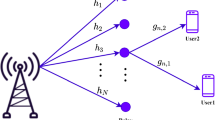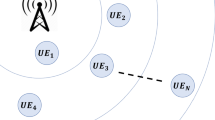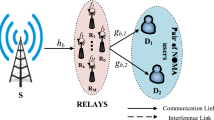Abstract
Virtual multi-input multi-output (vMIMO) schemes in wireless communication systems improve coverage, throughput, capacity, and quality of service. In this paper, we propose three uplink vMIMO relaying schemes based on detect–split–forward (DSF). In addition, we investigate the effect of several physical parameters such as distance, modulation type and number of relays. Furthermore, an adaptive vMIMO DSF scheme based on VBLAST and STBC is proposed. In order to do that, we provide analytical tools to evaluate the performance of the propose vMIMO relaying scheme.









Similar content being viewed by others
References
Rumney, M. (2009). LTE and the evolution to 4G wireless: Design and measurement challenges. USA: Wiley.
Liu, K. J. R., Sadek, A. K., & Kwasinski, A. (2009). Cooperative communications and networking. Cambridge: Cambridge University Press.
van der Meulen, E. (1971). Three-terminal communication channels. Advances in Applied Probability journal, 3, 120–154.
Laneman, J. N., Tse, D. N. C., & Wornell, G. W. (2004). Cooperative diversity in wireless networks: Efficient protocols and outage behavior. Information Theory, IEEE Transactions on, 50(12), 3062–3080.
IEEE Standard for Local and metropolitan area networks Part 16: Air Interface for Broadband Wireless Access Systems Amendment 1: Multiple Relay Specification. IEEE Std 802.16j-2009 (Amendment to IEEE Std 802.16-2009) (pp. c1–290). June 2009.
Wyner, A. D. (1976). The rate-distortion function for source coding with side information at the decoder-II: General sources. Information and Control, 38(1), 60–80.
Simoens, S., Muoz-Medina, O., Vidal, J., & Del Coso, A. (2010). Compress-and-forward cooperative MIMO relaying with full channel state information. IEEE Transactions on Signal Processing, 58(2), 781–791.
Dohler, M., Gkelias, A., & Aghvami, H. (2004). A resource allocation strategy for distributed MIMO multi-hop communication systems. IEEE Communications Letters, 8(2), 99–101.
Pabst, R., Walke, B. H., Schultz, D. C., Herhold, P., Yanikomeroglu, H., Mukherjee, S., et al. (2004). Relay-based deployment concepts for wireless and mobile broadband radio. IEEE Communications Magazine, 42(9), 80–89.
Wang, B., Zhang, J., & Host-Madsen, A. (2005). On the capacity of MIMO relay channels. IEEE Transactions on Information Theory, 51(1), 29–43.
Kim, Y., & Liu, H. (2008). Infrastructure relay transmission with cooperative MIMO. IEEE Transactions on Vehicular Technology, 57(4), 2180–2188.
Nessa, A., Yang, Q., & Kwak, K. S. (2011). Performance analysis of dual-hop cooperative MIMO transmission with relay selection in rayleigh fading channel. The International Arab Journal of Information Technology, 8(1), 9–15.
Abdaoui, A., Ikki, S. S., Ahmed, M. H., & Chatelet, E. (2010). On the performance analysis of a MIMO-relaying scheme with space time block codes. IEEE Transactions on Vehicular Technology, 59(7), 3604–3609.
Huo, P., & Cao, L. (2012). Distributed STBC with soft information relay based on Gaussian approximation. IEEE Signal Processing Letters, 19(10), 599–602.
Van Khuong, H., & Le-Ngoc, T. (2010). Performance analysis of a decode-and-forward cooperative relaying scheme for MIMO systems. In: The 25th Biennial symposium communications, 2010(pp. 400–403).
Song, C., Lee, K.-J., & Lee, I. (2010). Performance analysis of amplify-and-forward spatial multiplexing MIMO relaying systems. In: The IEEE international conference communications, 2010 (pp. 1–5).
Zhu, X., Song, Y., Yang, H., & Cai, L. (2009). 2-D switching diversity aided collaborative spatial multiplexing for uplink wireless access. In: IEEE wireless communications and networking conference, 2009 (pp. 1–4).
Balachandran, K., Calin, D., Gopalakrishnan, N., Kang, J. H., Kogiantis, A. G., Li, S., et al. (2009). Design and performance analysis of collaborative spatial multiplexing for IEEE 802.16e-based systems. Bell Labs Technical Journal, 13(4), 97–117.
Darmawan, A., Kim, S. W., & Morikawa, H. (2007). Amplify-and-forward scheme in cooperative spatial multiplexing. In: Mobile and wireless communications summit, 2007.16th IST (pp. 1–5). Budapest: IEEE.
Kim, S. W., & Cherukuri, R. (2005). Cooperative spatial multiplexing for high-rate wireless communications. In IEEE workshop signal processing advances in wireless communications (pp. 181–185).
Simon, M. K., & Alouini, M.-S. (2004). Digital communication over fading channels (Wiley Series in Telecommunications and Signal Processing). New York, NY: Wiley-IEEE Press.
Al-Shalan, F. (2000). Performance of quadrature amplitude modulation in Nakagami fading channels with diversity. thesis from King Fahd University of Petroleum and Minerals.
Al-Ghadhban, S. (2005). Multi-layered space frequency time codes. Phd thesis from Virginia Polytechnic Institute and State University.
Papadias, C., & Foschini, G. J. (2002). On the capacity of certain space-time coding schemes. EURASIP Journal on Applied Signal Processing, 5(1), 447–458.
Sandhu, S., & Paulraj, A. (2000). Space-time block codes: A capacity perspective. IEEE Communications Letters, 4(12), 384–386.
Acknowledgments
The authors would like to acknowledge the support provided by King Fahd University of Petroleum and Minerals (KFUPM) and King Abdulaziz City for Science and Technology (KACST) through the Science and Technology Unit at KFUPM for funding this work through project number 09-ELE781-4 as part of the National Science, Technology and Innovation Plan. In addition, Dr. Alghadhban would like to acknowledge the support provided by King Abdullah University of Science and Technology (KAUST) through RI project number EE002355.
Author information
Authors and Affiliations
Corresponding author
Rights and permissions
About this article
Cite this article
Al-Basit, S.M., Al-Ghadhban, S. & Zummo, S.A. Performance Analysis of Virtual MIMO Relaying Schemes Based on Detect–Split–Forward. Wireless Pers Commun 81, 711–724 (2015). https://doi.org/10.1007/s11277-014-2153-9
Published:
Issue Date:
DOI: https://doi.org/10.1007/s11277-014-2153-9




